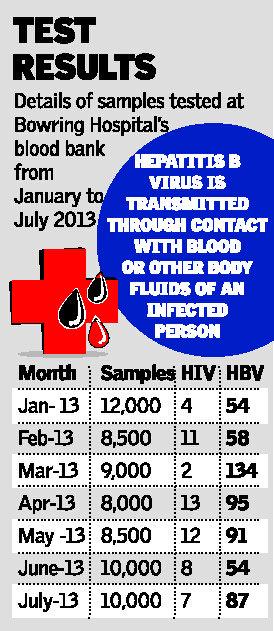 Bangalore, September 6: Of every 1,000 blood samples tested at the Individual Donor-Nucleic Acid Testing (ID-NAT) blood bank at Bowring and Lady Curzon Hospital here, an average of 12 are found to be positive for Hepatitis B Virus (HBV) and two for HIV.
Bangalore, September 6: Of every 1,000 blood samples tested at the Individual Donor-Nucleic Acid Testing (ID-NAT) blood bank at Bowring and Lady Curzon Hospital here, an average of 12 are found to be positive for Hepatitis B Virus (HBV) and two for HIV.
Officials from the blood bank who are detecting an increased number of HBV cases by using the ID-NAT method, an advanced screening technology, said that the detection of HBV cases was more than that of HIV.
This trend has been constant in the last two years.
‘Silent killer’
Doctors said that HBV, known as a “silent killer”, is more infectious than HIV and is the cause for liver cirrhosis, liver failure and liver cancer.
Hepatitis (liver inflammation) occurs when the liver, in reaction to harmful elements (commonly drugs, alcohol and viruses), swells and slowly loses its ability to function.
Hepatitis B Virus is not spread by contaminated food. It is transmitted through contact with blood or other body fluids of an infected person.
Symptoms
Parvesh Kumar Jain, head of the Department of Medical Gastroenterology in the State-run Bangalore Medical College and Research Institute (BMCRI), said that common symptoms include jaundice, diarrhoea, vomiting, abdominal pain and loss of appetite.
“While most recover from this short-term or acute condition, many cases progress to a chronic stage, wherein the liver is damaged. This can often end in serious life-threatening conditions such as internal bleeding and even liver cancer,” Dr. Jain said.
Bowring Hospital’s blood bank is the only facility in the State where samples from all the 34 government-run blood banks are tested using ID-NAT.
There are 178 blood banks in the State of which 66 are assisted by National AIDS Control Organisation (NACO).
Of the 66, 34 are run by the government and the others by NGOs.
Statistics
According to S. Manjunath, technical director of the laboratory, the detection of HBV was the highest in March when 134 cases of the total 9,000 samples tested were found to be positive.
In comparison, only two cases were found to be HIV positive.
Of the 12,000 samples in January, 54 tested positive for HBV and four for HIV. In February, of 8,500 samples, 58 were found to be HBV positive.
The number of HBV positive cases rose to 134 in March and came down to 95 in April and 91 in May when 8,000 and 8,500 samples were tested respectively. The cases reduced to 54 in June when 10,000 samples were tested, and again rose to 87 from 10,000 samples, according to Mr. Manjunath.
Recommendations
To tackle the disease effectively, a group of specialists has come out with six recommendations for the government, policy-makers, medical fraternity, pharmaceutical sector and other stakeholders.
The group, comprising S. Pruthvish, Professor and Head of Department of Community Medicine at M.S. Ramaiah Medical College and Hospital, and Ramakrishna Goud, Additional Professor, Department of Community Health, at St. John’s Medical College, among others, has recommended compulsory implementation of universal safety precautions in clinical practice to prevent spread of infections.
Implementation of an occupational policy with government mandate for the vulnerable sections (professionals in contact with blood and blood products), a mass movement for voluntary blood donation (serves the dual purpose of screening for hepatitis and availability of blood for emergencies), awareness and counselling for affected persons are the other recommendations.
